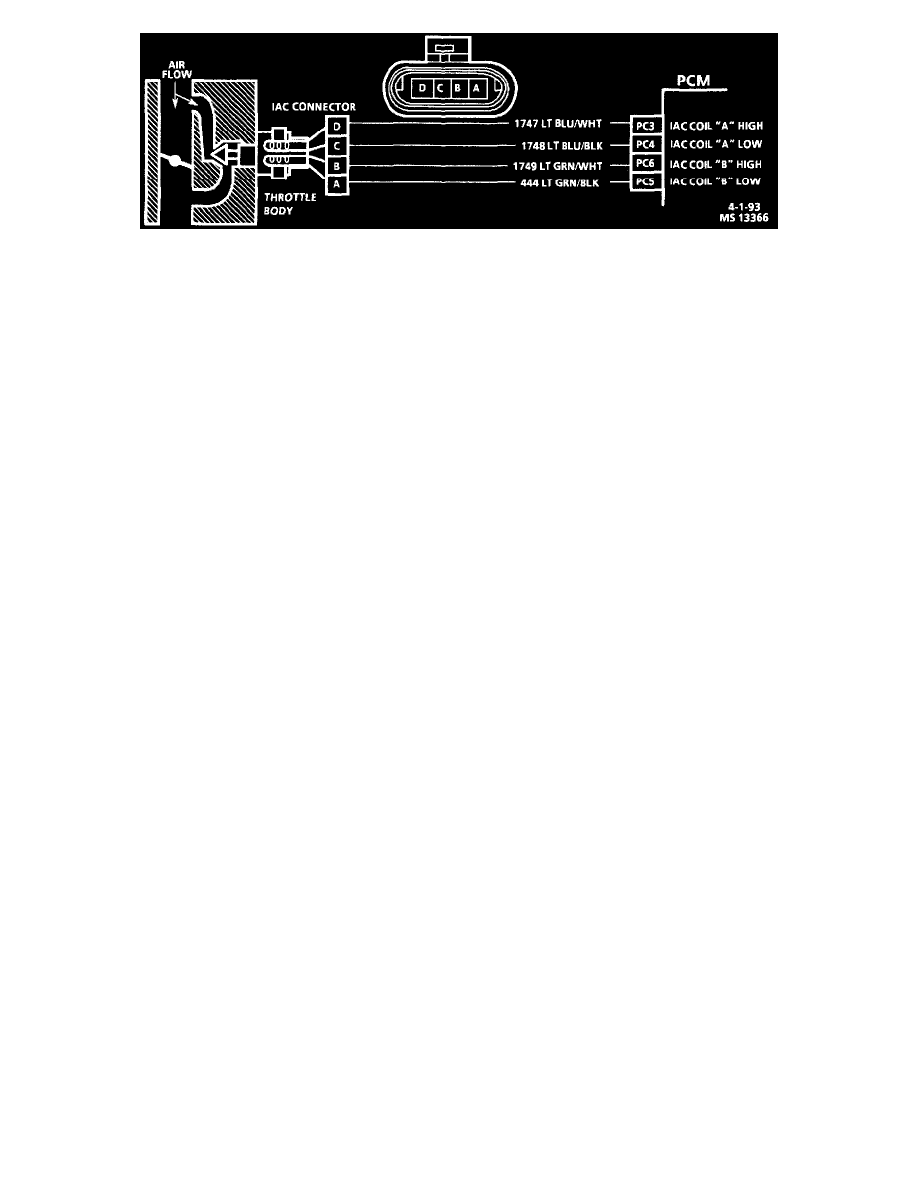Century L4-2.2L VIN 4 (1994)

Idle Air Control Wiring Circuit
Circuit Description:
The PCM controls engine idle speed with the IAC valve. To increase idle speed, the PCM retracts the IAC valve pintle away from its seat, allowing more
air to bypass the throttle bore. To decrease idle speed, it extends the IAC valve pintle towards its seat, reducing bypass air flow. A Tech 1 scan tool will
read the PCM commands to the IAC valve in counts. Higher counts indicate more air bypass (higher idle). Lower counts indicate less air is allowed to
bypass (lower idle).
Chart Test Description: Number(s) below refer to circled number(s) on the diagnostic chart.
1.
The Tech 1 RPM control mode is used to extend and retract the IAC valve. The valve should move smoothly within the specified range. If the idle
speed commanded (IAC extended) is too low (below 700 RPM), the engine may stall. This may be normal and would not indicate a problem.
Retracting the IAC beyond its controlled range (above 1500 RPM) will cause a delay before the RPMs start dropping. This too is normal.
2.
This test uses the Tech 1 to command the IAC controlled idle speed. The PCM issues commands to obtain commanded idle speed. The node lights
each should flash red and green to indicate a good circuit as the PCM issues commands. While the sequence of color is not important if either light
is "OFF" or does not flash red and green, check the circuits for faults, beginning with poor terminal contacts.
Diagnostic Aids: A slow, unstable, or fast idle may be caused by a non-IAC system problem that cannot be overcome by the IAC valve. Out of control
range IAC scan tool counts will be above 50 if idle is too low, and zero counts if idle is too high. The following checks should be made to repair a
non-IAC system problem:
^
Vacuum leak (high idle) - If idle is too high, stop the engine. Fully extend (low) IAC with tester. Start engine. If idle speed is above 800 RPM,
locate and correct vacuum leak including crankcase ventilation system. Also check for binding of throttle blade or linkage.
^
Crankcase ventilation valve - if a high idle condition exists (800 to 1000 RPM), check for vacuum leaks and proper crankcase ventilation valve
operation. All throttle bodies are preset at the factory and do not need adjustment. A missing crankcase ventilation valve or grommet or stuck
valve can cause this condition.
^
System too lean (high air/fuel ratio) - The idle speed may be too high or too low. Engine speed may vary up and down and disconnecting the IAC
valve does not help. DTC 44 may be set. Scan oxygen voltage will be less than 300 mV (.3 volt). Check for low regulated fuel pressure, water in
the fuel or a restricted injector.
^
System too rich (low air/fuel ratio) - The idle speed will be too low. Scan tool IAC counts will usually be above 50. System is obviously rich and
may exhibit black smoke in exhaust.
Scan tool oxygen voltage will be fixed above 800mV (.8 volt).
Check for high fuel pressure, leaking or sticking injector. Silicone contaminated oxygen sensors scan voltage will be slow to respond.
^
Throttle body - Remove IAC valve and inspect bore for foreign material.
^
IAC valve electrical connections - IAC valve connections should be carefully checked for proper contact.
^
Refer to "Rough, Unstable, Incorrect Idle, or Stalling" in "Diagnosis By Symptom."
^
If intermittent, poor driveability or idle symptoms are resolved by disconnecting the IAC, carefully recheck connections, valve terminal
resistance, or replace IAC.
